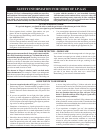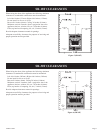
Page 6 16009-1-0504
WATER VAPOR: A BY-PRODUCT OF UNVENTED ROOM HEATERS
Water vapor is a by-product of gas combustion. An unvented
room heater produces approximately one (1) ounce (30ml) of
water for every 1,000 BTU's (.3KW's) of gas input per hour.
Unvented room heaters must be used as supplemental heat (a
room) rather than a primary heat source (an entire house). In most
supplemental heat applications, the water vapor does not create a
problem. In most applications, the water vapor enhances the low
humidity atmosphere experienced during cold weather.
The following steps will help insure that water vapor does not
become a problem.
1. Be sure the heater is sized properly for the application, including
ample combustion air and circulation air.
2. If high humidity is experienced, a dehumidifier may be used to
help lower the water vapor content of the air.
3. Do not use an unvented room heater as the primary heat source
(an entire house).
PROVISIONS FOR ADEQUATE COMBUSTION & VENTILATION AIR
This heater shall not be installed in a confined space or unusually
tight construction unless provisions are provided for adequate
combustion and ventilation air.
The National Fuel Gas Code, ANSI Z223.1 defines a confined
space as a space whose volume is less than 50 cubic feet per 1,000
Btu per hour (4.8m
3
per kw) of the aggregate input rating of all
appliances installed in that space and an unconfined space as a
space whose volume is not less than 50 cubic feet per 1,000 Btu
per hour (4.8m
3
per kw) of the aggregate input rating of all
appliances installed in that space. Rooms communicating di-
rectly with the space in which the appliances are installed,
through openings not furnished with doors, are considered a part
of the unconfined space.
The following example is for determining the volume of a typical
area in which the SR-30T may be located and for determining if
this area fits the definition of an unconfined space.
The input of the SR-30T is 30,000 Btu per hour. Based on the 50
cubic feet per 1,000 Btu per hour formula, the minimum area that
is an unconfined space for installation of the SR-30T is 1,500
cubic feet, 50 cubic feet x 30 = 1,500 cubic feet. To determine the
cubic feet of the area in which the SR-30T is to be installed,
measure the length, width and height of the area. Example: The
area measures 16 feet in length, 12 feet in width and 8 feet in
height, the area is 1,536 cubic feet. The SR-30T can be installed
in this unconfined space with no requirement to provide addi-
tional combustion and ventilation air.
Warning: If the area in which the heater may be operated is
smaller than that defined as an unconfined space or if the building
is of unusually tight construction, provide adequate combustion
and ventilation air by one of the methods described in the
National Fuel Gas Code, ANSI Z223.1, Section 5.3 or applicable
local codes.
Unusually Tight Construction
The air that leaks around doors and windows may provide enough
fresh air for combustion and ventilation. However, in buildings of
unusually tight construction, you must provide additional fresh
air.
Unusually tight construction is defined as construction
where:
a. Walls and ceilings exposed to the outside atmosphere have
a continuous water vapor retarder with a rating of one perm
or less with openings gasketed or sealed, and
b. Weatherstripping has been added on openable windows
and doors, and
c. Caulking or sealants are applied to areas such as joints
around window and door frames, between sole plates and
floors, between wall-ceiling joints, between wall panels, at
penetrations for plumbing, electrical, and gas lines, and at
other openings.
If the SR-30T heater is installed in a building of unusually tight
construction, adequate air for combustion, ventilation and dilu-
tion of flue gases shall be provided in accordance with ANSI
Z223.1/NFPA54.


















